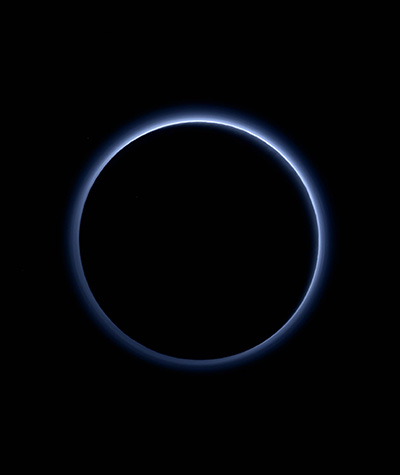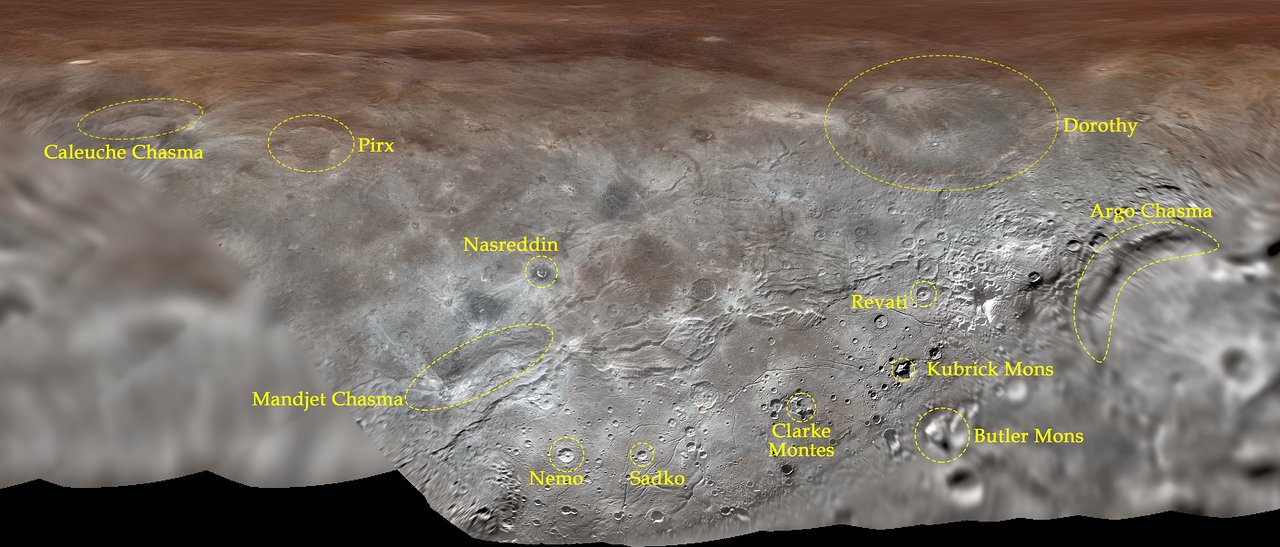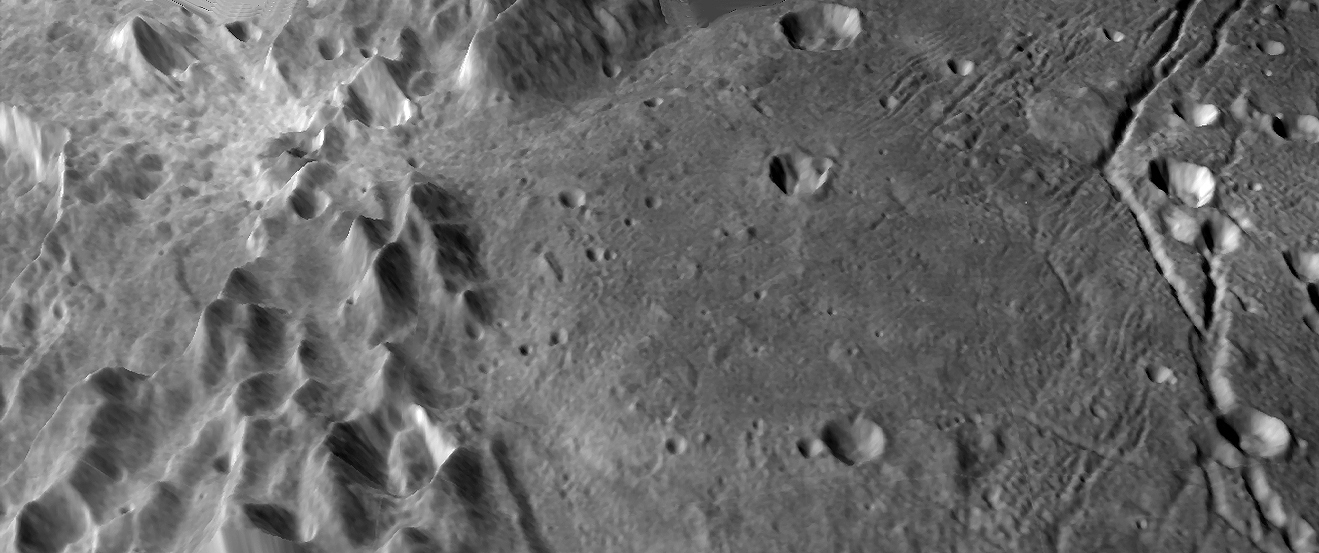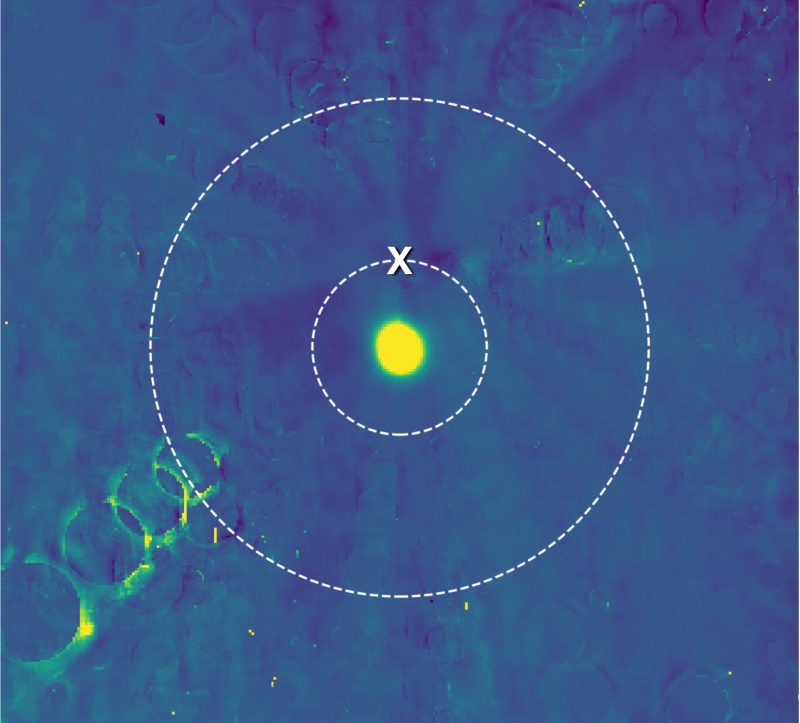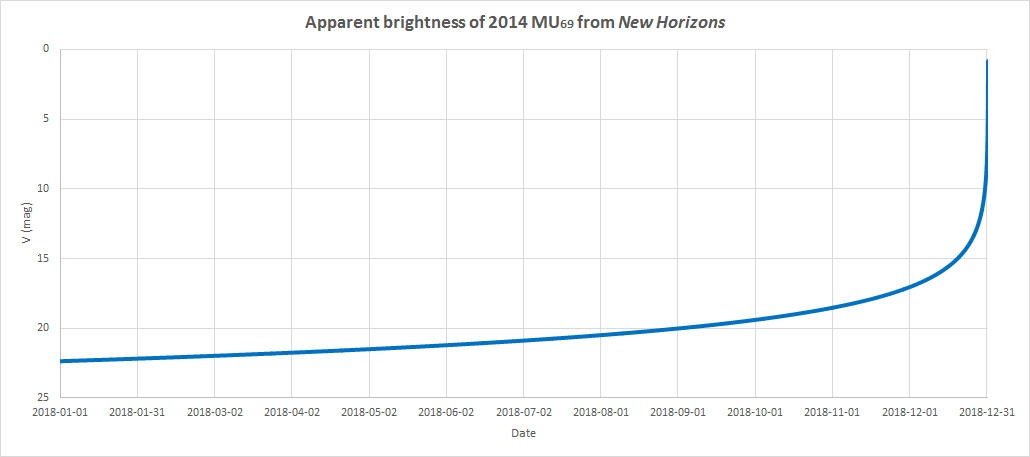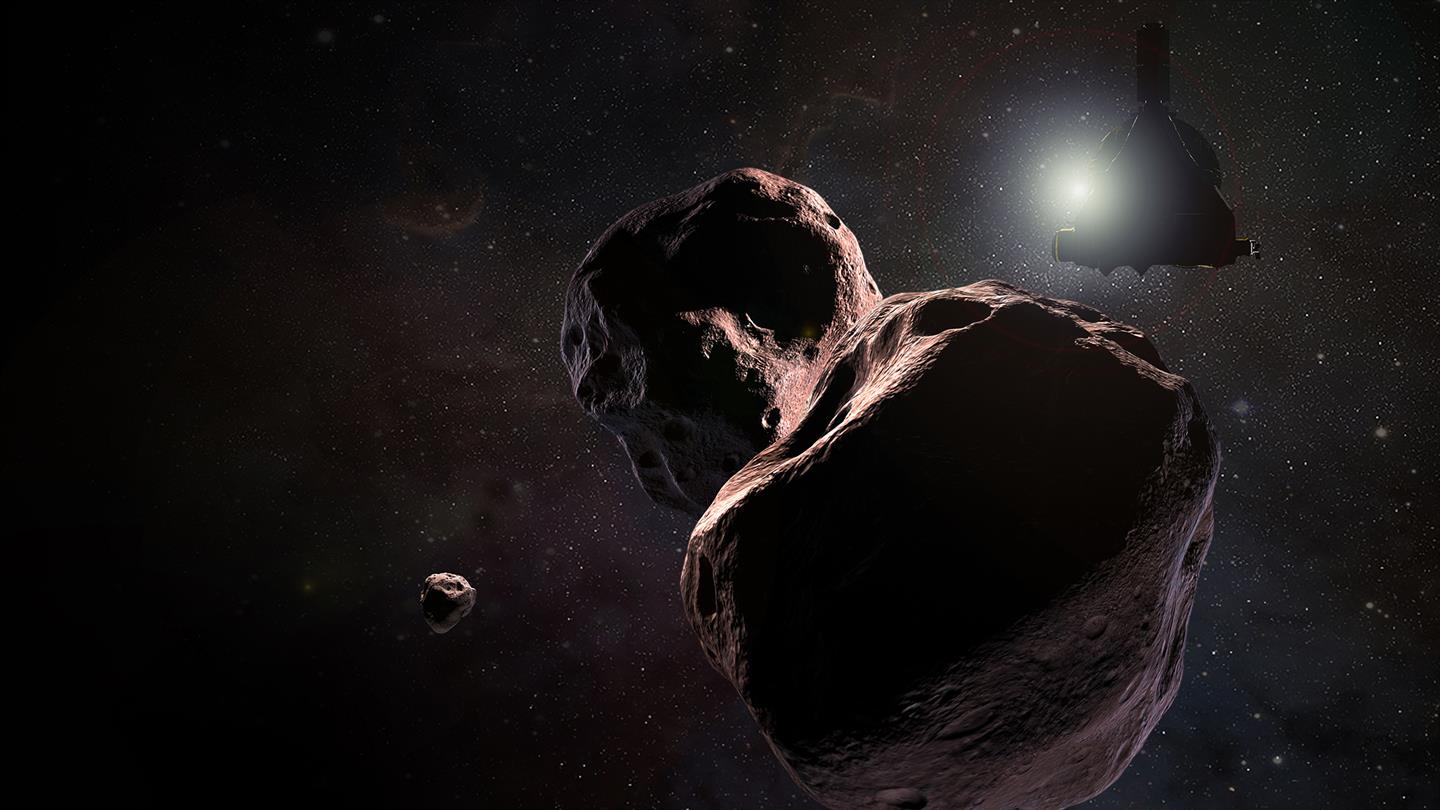Page 22 of 25
Help Nickname New Horizons' Next Flyby Target
Posted: Tue Nov 07, 2017 4:36 pm
by bystander
Help Nickname New Horizons' Next Flyby Target
NASA |
JHUAPL | SETI | New Horizons | 2017 Nov 06
NASA's New Horizons mission to Pluto and the Kuiper Belt is looking for your ideas on what to informally name its next flyby destination, a billion miles (1.6 billion kilometers) past Pluto.
On New Year's Day 2019, the New Horizons spacecraft will fly past a small, frozen world in the Kuiper Belt, at the outer edge of our solar system. The target Kuiper Belt object (KBO) currently goes by the official designation "
(486958) 2014 MU69." NASA and the New Horizons team are
asking the public for help in giving "MU69" a nickname to use for this exploration target. ...
The naming campaign is hosted by the SETI Institute of Mountain View, California, and led by Mark Showalter, an institute fellow and member of the New Horizons science team. The website includes names currently under consideration; site visitors can vote for their favorites or nominate names they think should be added to the ballot. "The campaign is open to everyone," Showalter said. "We are hoping that somebody out there proposes the perfect, inspiring name for MU69."
The campaign will close at 3 p.m. EST/noon PST on Dec. 1. NASA and the New Horizons team will review the top vote-getters and announce their selection in early January.
To submit your suggested names and to vote for your favorites, go to:
http://frontierworlds.seti.org
UCSC: Hydrocarbon Haze Keeps Pluto Colder Than Expected
Posted: Fri Nov 17, 2017 3:54 pm
by bystander
Pluto's Hydrocarbon Haze Keeps Pluto Colder Than Expected
University of California, Santa Cruz | 2017 Nov 15
The gas composition of a planet's atmosphere generally determines how much heat gets trapped in the atmosphere. For the dwarf planet Pluto, however, the predicted temperature based on the composition of its atmosphere was much higher than actual measurements taken by NASA's New Horizons spacecraft in 2015.
A new study published November 16 in
Nature proposes a novel cooling mechanism controlled by haze particles to account for Pluto's frigid atmosphere. ...
The cooling mechanism involves the absorption of heat by the haze particles, which then emit infrared radiation, cooling the atmosphere by radiating energy into space. The result is an atmospheric temperature of about 70 Kelvin (minus 203 degrees Celsius, or minus 333 degrees Fahrenheit), instead of the predicted 100 Kelvin (minus 173 Celsius, or minus 280 degrees Fahrenheit). ...
Extensive layers of atmospheric haze can be seen in images of Pluto taken by New Horizons. The haze results from chemical reactions in the upper atmosphere, where ultraviolet radiation from the sun ionizes nitrogen and methane, which react to form tiny hydrocarbon particles tens of nanometers in diameter. As these tiny particles sink down through the atmosphere, they stick together to form aggregates that grow larger as they descend, eventually settling onto the surface. ...
The researchers are interested in studying the effects of haze particles on the atmospheric energy balance of other planetary bodies, such as Neptune's moon Triton and Saturn's moon Titan. Their findings may also be relevant to investigations of exoplanets with hazy atmospheres. ...
Haze heats Pluto’s atmosphere yet explains its cold temperature - Xi Zhang, Darrell F. Strobel, Hiroshi Imanaka
Re: Where New Horizons is
Posted: Fri Nov 17, 2017 11:57 pm
by BDanielMayfield
The haze results from chemical reactions in the upper atmosphere, where ultraviolet radiation from the sun ionizes nitrogen and methane, which react to form tiny hydrocarbon particles tens of nanometers in diameter. As these tiny particles sink down through the atmosphere, they stick together to form aggregates that grow larger as they descend, eventually settling onto the surface. ...
In other words, it snows frozen smog on Pluto.
Does New Horizons' Next Target Have a Moon?
Posted: Wed Dec 13, 2017 4:13 pm
by bystander
Does New Horizons' Next Target Have a Moon?
NASA |
JHU-APL | SwRI | New Horizons | 2017 Dec 12
On three occasions in June and July 2017, New Horizons mission team
members attempted to track a small, distant Kuiper Belt object, 2014 MU69,
as it passed in front of a star – an event known as an occultation. The colored
lines mark the path of the star as seen from different telescopes on each day;
the blank spaces on those lines indicate the few seconds when MU69 blocked
the light from the star. Scientists are using these observations to craft a
picture of MU69 and any companion bodies.
Credits: NASA/JHUAPL/SwRI/James Tuttle Keane[
Scientists were already excited to learn this summer that New Horizons' next flyby target – a Kuiper Belt object a billion miles past Pluto – might be either peanut-shaped or even two objects orbiting one another. Now new data hints that 2014 MU69 might have company: a small moon.
That's the latest theory coming from NASA's New Horizons team, as it continues to analyze telescope data on the target of a New Year's Day 2019 flyby. "We really won't know what MU69 looks like until we fly past it, or even gain a full understanding of it until after the encounter," said New Horizons science team member Marc Buie, of the Southwest Research Institute, Boulder, Colorado, who offered an update on the analysis of MU69 Monday at the American Geophysical Union Fall Meeting in New Orleans. "But even from afar, the more we examine it, the more interesting and amazing this little world becomes."
The data that led to these hints at MU69's nature were gathered over six weeks in June and July, when the team made three attempts to place telescopes in the narrow shadow of MU69 as it passed in front of a star. The most valuable recon came on July 17, when five telescopes deployed by the New Horizons team in Argentina were in the right place at the right time to catch this fleeting shadow — an event known as an occultation – and capture important data on MU69's size, shape and orbit. That data raised the possibility that MU69 might be two like-sized objects, or what's known as a binary. ...
Spend Next New Year's Eve with New Horizons
Posted: Fri Jan 05, 2018 4:49 pm
by bystander
Spend Next New Year's Eve with New Horizons
NASA |
JHU-APL | SwRI | New Horizons | 2018 Jan 04
[img3="Artist’s impression of NASA’s New Horizons spacecraft encountering 2014 MU69, a Kuiper Belt object that orbits one billion miles (1.6 billion kilometers) beyond Pluto, on Jan. 1, 2019. Credits: NASA/JHUAPL/SwRI/Steve Gribben"]https://www.nasa.gov/sites/default/file ... ary_sm.jpg[/img3][hr][/hr] The New Year's celebration to usher in 2019 will include an event like no other – more than four billion miles from Earth.
In just under a year – shortly after midnight Eastern Time on Jan. 1, 2019 – NASA's New Horizons spacecraft will buzz by the most primitive and most distant object ever explored. New Horizons' encounter with Kuiper Belt object 2014 MU69, which orbits a billion miles beyond Pluto, will offer the first close-up up look at such a pristine building block of the solar system – and will be performed in a region of deep space that was practically unknown just a generation ago. ...
New Horizons will fly about three times closer to MU69 than it did to Pluto in July 2015, allowing the spacecraft’s cameras to provide a more detailed look at the object’s surface. Project Scientist Hal Weaver, of the Johns Hopkins Applied Physics Laboratory (APL) in Laurel, Maryland, pointed out that New Horizons’ vantage point from about 2,175 miles (3,500 kilometers) from MU69 will allow it spot details about the size of a basketball court. ...
New Horizons Captures Images in the Kuiper Belt
Posted: Sun Feb 11, 2018 8:18 pm
by bystander
New Horizons Captures Record-Breaking Images in the Kuiper Belt
JHU-APL |
NASA | SwRI | New Horizons | 2018 Feb 08
NASA's New Horizons spacecraft recently turned its telescopic camera toward a field of stars, snapped an image – and made history.
The routine calibration frame of the "
Wishing Well" galactic open star cluster, made by the Long Range Reconnaissance Imager (
LORRI) on Dec. 5, was taken when New Horizons was 3.79 billion miles (6.12 billion kilometers, or 40.9 astronomical units) from Earth – making it, for a time, the farthest image ever made from Earth.
New Horizons was even farther from home than NASA's Voyager 1 when it captured the famous "
Pale Blue Dot" image of Earth. That picture was part of a composite of 60 images looking back at the solar system, on Feb. 14, 1990, when Voyager was 3.75 billion miles (6.06 billion kilometers, or about 40.5 astronomical units [AU]) from Earth. Voyager 1's cameras were turned off shortly after that portrait, leaving its distance record unchallenged for more than 27 years.
LORRI broke its own record just two hours later with images of Kuiper Belt objects 2012 HZ84 and 2012 HE85 – further demonstrating how nothing stands still when you're covering more than 700,000 miles (1.1 million kilometers) of space each day. ...
Re: Where New Horizons is
Posted: Mon Feb 12, 2018 4:19 am
by neufer
https://en.wikipedia.org/wiki/15810_Arawn wrote:
<<15810 Arawn, provisional designation 1994 JR1, is a trans-Neptunian object (TNO) from the inner regions of the Kuiper belt, approximately 133 kilometres in diameter. It belongs to the plutinos, the largest class of resonant TNOs. It was named after Arawn, the ruler of the Celtic underworld, and discovered on 12 May 1994, by astronomers Michael Irwin and Anna Żytkow with the 2.5-metre Isaac Newton Telescope at La Palma Observatory in the Canary Islands, Spain.

Arawn is unique in that it has been observed at a much closer distance than most Kuiper belt objects, by the New Horizons spacecraft, which imaged it a distance of 111 million km (0.74 AU) in April 2016; this and its other observations have allowed its [5.47 hour] rotation period to be determined.
Arawn is moving in a relatively eccentric orbit entirely beyond the orbit of Neptune. With a semi-major axis of 39.4 AU, it orbits the Sun once every 247 years and 6 months. Its orbit has perihelion (closest approach to the Sun) of 34.7 AU, an aphelion (farthest distance from the Sun) of 44.1 AU, an eccentricity of 0.12 and an inclination of 4° with respect to the ecliptic. It is a plutino, being trapped in a 2:3 mean motion resonance with Neptune, similarly to dwarf planet Pluto, the largest known plutino.
In 2012, Arawn was hypothesized to be in a quasi-satellite loop around Pluto, as part of a recurring pattern, becoming a Plutonian quasi-satellite every 2 Myr and remaining in that phase for nearly 350,000 years. Measurements made by the New Horizons probe in 2015 made it possible to calculate the motion of Arawn much more accurately. These calculations confirm the general dynamics described in the hypotheses. However, it is not agreed upon among astronomers whether Arawn should be classified as a quasi-satellite of Pluto based on this motion, since its orbit is primarily controlled by Neptune with only occasional smaller perturbations caused by Pluto.>>
Re: Where New Horizons is
Posted: Tue Mar 06, 2018 11:04 pm
by orin stepanek
New Horizons to get closer to the KBO than it did to Pluto! Should get some good pictures on New Years 2019!

 https://www.nasaspaceflight.com/2017/01 ... encounter/
https://www.nasaspaceflight.com/2017/01 ... encounter/ written by Chris Gebhardt
Re: Where New Horizons is
Posted: Tue Mar 06, 2018 11:23 pm
by neufer
orin stepanek wrote: ↑Tue Mar 06, 2018 11:04 pm
New Horizons to get closer to the KBO than it did to Pluto! Should get some good pictures on New Years 2019!
https://en.wikipedia.org/wiki/Point_of_no_return wrote:
<<The point of no return (PNR or PONR) is the point beyond which one must continue on one's current course of action because turning back is physically impossible, prohibitively expensive, or dangerous. The phrase "point of no return" originated as a technical term in air navigation to refer to the point on a flight at which a plane is no longer capable of returning to the airfield from which it took off.>>
New Horizons Chooses Nickname for 'Ultimate' Flyby Target
Posted: Wed Mar 14, 2018 3:46 pm
by bystander
New Horizons Chooses Nickname for 'Ultimate' Flyby Target
NASA |
JHU-APL | SwRI | New Horizons | 2018 Mar 13
As NASA's New Horizons mission continues exploring the unknown, the mission team has selected a highly appropriate nickname for its next flyby target in the outer reaches of the solar system.
With substantial public input, the team has chosen "Ultima Thule" (pronounced ultima thoo-lee") for the Kuiper Belt object the New Horizons spacecraft will explore on Jan. 1, 2019. Officially known as 2014 MU69, the object, which orbits a billion miles beyond Pluto, will be the most primitive world ever observed by spacecraft – in the farthest planetary encounter in history.
Thule was a mythical, far-northern island in medieval literature and cartography. Ultima Thule means "beyond Thule"– beyond the borders of the known world—symbolizing the exploration of the distant Kuiper Belt and Kuiper Belt objects that New Horizons is performing, something never before done. ...
IAU: Charon Gets Its First Official Feature Names
Posted: Thu Apr 12, 2018 5:26 pm
by bystander
Pluto’s Largest Moon, Charon, Gets Its First Official Feature Names
International Astronomical Union | 2018 Apr 11
Legendary explorers and visionaries, real and fictitious, are among those immortalized by the IAU in the first set of official surface-feature names for Pluto’s largest moon, Charon. The names were proposed by the New Horizons team and approved by IAU Working Group for Planetary System Nomenclature.
The International Astronomical Union (IAU), the internationally recognized authority for naming celestial bodies and their surface features, recently approved a dozen names proposed by NASA's New Horizons team, which led the first reconnaissance of Pluto and its moons in 2015 with the New Horizons spacecraft. The New Horizons team had been using many of the chosen names informally to describe the many valleys, crevices and craters discovered during the first close-up look at the surface Charon. ...
The approved Charon names focus on the literature and mythology of exploration. They are listed here:
- Argo Chasma is named for the ship sailed by Jason and the Argonauts, in the epic Latin poem Argonautica, during their quest for the Golden Fleece.
- Butler Mons honours Octavia E. Butler, the first science fiction writer to win a MacArthur fellowship, and whose Xenogenesis trilogy describes humankind’s departure from Earth and subsequent return.
- Caleuche Chasma is named for the mythological ghost ship that travels the seas around the small island of Chiloé, off the coast of Chile; according to legend, the Caleuche explores the coastline collecting the dead, who then live aboard it forever.
- Clarke Montes honours Sir Arthur C. Clarke, the prolific science fiction writer and futurist whose novels and short stories (including 2001: A Space Odyssey) were imaginative depictions of space exploration.
- Dorothy Crater recognizes the protagonist in the series of children’s novels, by L. Frank Baum, that follows Dorothy Gale’s travels to and adventures in the magical world of Oz.
- Kubrick Mons honours film director Stanley Kubrick, whose iconic 2001: A Space Odyssey tells the story of humanity’s evolution from tool-using hominids to space explorers and beyond.
- Mandjet Chasma is named for one of the boats in Egyptian mythology that carried the sun god Ra (Re) across the sky each day — making it one of the earliest mythological examples of a vessel of space travel.
- Nasreddin Crater is named for the protagonist in thousands of humorous folktales told throughout the Middle East, southern Europe and parts of Asia.
- Nemo Crater is named for the captain of the Nautilus, the submarine in Jules Verne’s novels Twenty Thousand Leagues Under the Sea (1870) and The Mysterious Island (1874).
- Pirx Crater is named for the main character in a series of short stories by Stanislaw Lem, who travels between the Earth, Moon and Mars.
- Revati Crater is named for the main character in the Hindu epic narrative Mahabharata — widely regarded as the first in history (circa 400 BC) to include the concept of time travel.
- Sadko Crater recognizes the adventurer who travelled to the bottom of the sea in the medieval Russian epic Bylina.
New Horizons Wakes for Historic Kuiper Belt Flyby
Posted: Thu Jun 07, 2018 2:48 pm
by bystander
New Horizons Wakes for Historic Kuiper Belt Flyby
NASA | JHUAPL | SwRI | New Horizons | 2018 Jun 05
NASA's New Horizons spacecraft is back "awake" and being prepared for the farthest planetary encounter in history – a New Year's Day 2019 flyby of the Kuiper Belt object nicknamed Ultima Thule.
Cruising through the Kuiper Belt more than 3.7 billion miles (6 billion kilometers) from Earth, New Horizons had been in resource-saving hibernation mode since Dec. 21. Radio signals confirming that New Horizons had executed on-board computer commands to exit hibernation reached mission operations at the Johns Hopkins Applied Physics Laboratory in Laurel, Maryland, via NASA's Deep Space Network at 2:12 a.m. EDT on June 5.
Mission Operations Manager Alice Bowman of APL reported that the spacecraft was in good health and operating normally, with all systems coming back online as expected.
Over the next three days, the mission team will collect navigation tracking data (using signals from the Deep Space Network) and send the first of many commands to New Horizons' onboard computers to begin preparations for the Ultima flyby; lasting about two months, those flyby preparations include memory updates, Kuiper Belt science data retrieval, and a series of subsystem and science-instrument checkouts. In August, the team will command New Horizons to begin making distant observations of Ultima, images that will help the team refine the spacecraft's course to fly by the object. ...
USRA/LPI: First Global Maps of Pluto & Charon Published
Posted: Tue Jul 10, 2018 6:15 pm
by bystander
First Global Maps of Pluto and Charon Published
Universities Space Research Association | Lunar and Planetary Institute | 2018 Jul 10
Until 2015, it was not known whether icy Pluto or its largest moon, Charon, had mountains, valleys or even impact craters. After the spectacular success of New Horizons in July 2015, scientists were amazed at the towering peaks and deep valleys that were revealed in the returned data. Now, thanks to the efforts of the New Horizons team, the first official validated global map and topographic maps of these two bodies have been published and are available to all. The maps and the process of creating them are described in two new research articles published in the journal Icarus.
To create the maps, New Horizons researchers, led by Senior Staff Scientist, Paul Schenk, at the Lunar and Planetary Institute, registered all the images from the Long Range Reconnaissance Imager (LORRI) and Multispectral Visible Imaging Camera (MVIC) systems together and assembled the mosaics. This was a labor-intensive effort requiring detailed alignment of surface features in overlapping images. Digital analysis of stereo images obtained by both cameras were used to create topographic maps for each region; these were then assembled into integrated topographic maps for each body. These new maps of Pluto and Charon were produced painstakingly over a two-year period as data were slowly transmitted to Earth from the New Horizons spacecraft. The quality of geographically and topographically accurate maps improved with each new batch of images that were returned to Earth.
The validated global cartographic and topographic maps show the best resolution for each area illuminated by the Sun, and their elevations. These maps reveal a rich variety of landforms on both Pluto and Charon. The topographic maps confirm that the highest known mountains on Pluto are the Tenzing Montes range, which formed along the southwestern margins of the frozen nitrogen ice sheet of Sputnik Planitia. These steep-sided icy peaks have slopes of 40° or more and rise several kilometers above the floor of Sputnik Planitia. The highest peak rises approximately 6 kilometers (3.7 miles) above the base of the range, comparable to base-to-crest heights of Denali in Alaska, and Kilimanjaro in Kenya. Pluto's mountains must be composed of stiff water ice in order to maintain their heights, as the more volatile ices observed on Pluto, including methane and nitrogen ice, would be too weak and the mountains would collapse. ...
Basins, fractures and volcanoes: Global cartography
and topography of Pluto from New Horizons - Paul Michael Schenk
et al
Breaking up is hard to do: Global cartography and topography
of Pluto's mid-sized icy Moon Charon from New Horizons - Paul Michael Schenk
et al
JHUAPL/NASA/SwRI: New Horizons Team Prepares for Stellar Occultation
Posted: Thu Aug 02, 2018 5:24 pm
by bystander
Team Prepares for Stellar Occultation Ahead of Ultima Thule Flyby
NASA |
JHUAPL | SwRI | New Horizons | 2018 Aug 02
Successfully observing an object from more than four billion miles away is difficult, yet NASA’s New Horizons mission team is banking that they can do that -- again.
Preparations are on track for a final set of stellar occultation observations to gather as much information about the size, shape, environment, and other conditions around New Horizons’ next flyby target, the ancient Kuiper Belt object 2014 MU69, nicknamed Ultima Thule.
The occultation team used data from the Hubble Space Telescope and European Space Agency’s Gaia satellite to pinpoint two roughly 18.5-mile (30-kilometer) strips on Earth where Ultima Thule will cast its shadow on August 4th. Telescopes will be placed at multiple points in those strips to attempt to observe the occultation when Ultima Thule passes in front of a star and momentarily blocks its light. In a similar effort in 2017, the team struck observation gold from multiple sites in Patagonia, Argentina. Fighting high winds and extreme winter conditions, team members captured an occultation from five sites, a major success that taught them much about the flyby target and helped define the flyby distance of 2,175 miles (3,500 kilometers). ...
The final occultation observations of Ultima Thule are scheduled for Aug. 4 in Senegal and Colombia, with Buie again leading the effort. ...
Re: Where New Horizons is
Posted: Thu Aug 02, 2018 6:30 pm
by neufer
Daniel Bamberger/NASA/JHUAPL/SwRI/Alex Parker/ESA wrote:
Size comparison of 2014 MU69 
and comet Churyumov–Gerasimenko.
The image is an artist's concept, based on stellar occultation data.
Daniel Bamberger/NASA/JHUAPL/SwRI/Alex Parker/ESA
https://en.wikipedia.org/wiki/The_Game_of_Cootie wrote:
<<In 1948, Minneapolis, Minnesota postman William H. Schaper whittled a bug-like fishing lure he believed had toy potential, and sold it (and others like it) in his store as a sideline to his homebound business of manufacturing small commercial popcorn machines. Eventually, he created a game around his creation, and, in 1949, molded it in plastic and formed the W. H. Schaper Mfg. Co. Inc.. The Game of Cootie is a children's roll-and-move tabletop game for two to four players. The object is to be the first to build a three-dimensional bug-like object called a "cootie" from a variety of plastic body parts. The game was launched in 1949 and sold millions in its first years.
The earliest recorded use of the word "cootie" appears in Albert N. Depew's World War I memoir, Gunner Depew (1918): "Of course you know what the word 'cooties' means....When you get near the trenches you get a course in the natural history of bugs, lice, rats and every kind of pest that had ever been invented." The word may be derived from Malaysian kutu, a head louse. In North American English, children use the word to refer to a fictitious disease or condition, often infecting members of the opposite sex.>>
JHUAPL/NASA/SwRI: First Detection of Kuiper Belt Flyby Target
Posted: Wed Aug 29, 2018 4:44 pm
by bystander
New Horizons Makes First Detection of Kuiper Belt Flyby Target
NASA |
JHUAPL | SwRI | New Horizons | 2018 Aug 28
NASA's New Horizons spacecraft has made its first detection of its next flyby target, the Kuiper Belt object nicknamed Ultima Thule, more than four months ahead of its New Year's 2019 close encounter.
Mission team members were thrilled – if not a little surprised – that New Horizons’ telescopic Long Range Reconnaissance Imager (LORRI) was able to see the small, dim object while still more than 100 million miles away, and against a dense background of stars. Taken Aug. 16 and transmitted home through NASA’s Deep Space Network over the following days, the set of 48 images marked the team’s first attempt to find Ultima with the spacecraft's own cameras. ...
This first detection is important because the observations New Horizons makes of Ultima over the next four months will help the mission team refine the spacecraft's course toward a closest approach to Ultima, at 12:33 a.m. EST on Jan. 1, 2019. That Ultima was where mission scientists expected it to be – in precisely the spot they predicted, using data gathered by the Hubble Space Telescope – indicates the team already has a good idea of Ultima’s orbit.
The Ultima flyby will be the first-ever close-up exploration of a small Kuiper Belt object and the farthest exploration of any planetary body in history, shattering the record New Horizons itself set at Pluto in July 2015 by about 1 billion miles. These images are also the most distant from the Sun ever taken, breaking the record set by Voyager 1’s “Pale Blue Dot” image of Earth taken in 1990. (New Horizons set the record for the most distant image from Earth in December 2017.)
New Horizons Sets Up for New Year's Flyby of Ultima Thule
Posted: Sat Oct 06, 2018 3:02 am
by bystander
New Horizons Sets Up for New Year's Flyby of Ultima Thule
JHU-APL | NASA | SwRI | New Horizons | 2018 Oct 05
Just 33 minutes into the New Year (Eastern Time), New Horizons will fly approximately
2,200 miles from the surface of a Kuiper Belt object nicknamed Ultima Thule – making
it the farthest planetary object ever visited by a spacecraft.
Image Credit: Roman Tkachenko
NASA's New Horizons spacecraft carried out a short engine burn on Oct. 3 to home in on the location and timing of its New Year's flyby of the Kuiper Belt object nicknamed Ultima Thule.
Word from the spacecraft that it had successfully performed the 3½-minute maneuver reached mission operations at the Johns Hopkins Applied Physics Laboratory in Laurel, Maryland, at around 10:20 p.m. EDT. The maneuver slightly tweaked the spacecraft's trajectory and bumped its speed by 2.1 meters per second – just about 4.6 miles per hour – keeping it on track to fly past Ultima (officially named 2014 MU69) at 12:33 am EST on Jan. 1, 2019.
"Thanks to this maneuver, we're right down the middle of the pike and on time for the farthest exploration of worlds in history – more than a billion miles beyond Pluto," said mission Principal Investigator Alan Stern of the Southwest Research Institute. "It almost sounds like science fiction, but it's not. Go New Horizons!"
At 4.1 billion miles (6.6 billion kilometers) from Earth, Ultima Thule will be the most distant object ever visited by a spacecraft. New Horizons itself was about 3.95 billion miles (6.35 billion kilometers) from home when it carried out Wednesday's trajectory correction maneuver (TCM), the farthest course-correction ever performed.
This was the first Ultima targeting maneuver that used pictures taken by New Horizons itself to determine the spacecraft's position relative to the Kuiper Belt object. These "optical navigation" images – gathered by New Horizons' Long Range Reconnaissance Imager (LORRI) – provide direct information of Ultima's position relative to New Horizons, and help the team determine where the spacecraft is headed. ...
Re: Where New Horizons is
Posted: Sun Dec 02, 2018 12:45 pm
by orin stepanek
Every day; it's a getting closer! Before we realize it; it'll be over! hope we get some good Pics!

JHUAPL: New Horizons Takes the Inside Course to Ultima Thule
Posted: Tue Dec 18, 2018 5:06 pm
by bystander
New Horizons Takes the Inside Course to Ultima Thule
Johns Hopkins University Applied Physics Laboratory | 2018 Dec 18
Mission Team Sees No Moons or Rings Near Ultima, Opts for Primary Flyby Path
With no apparent hazards in its way, NASA's New Horizons spacecraft has been given a "go" to stay on its optimal path to Ultima Thule as it speeds closer to a Jan. 1 flyby of the Kuiper Belt object a billion miles beyond Pluto – the farthest planetary flyby in history.
After almost three weeks of sensitive searches for rings, small moons and other potential hazards around the object, New Horizons Principal Investigator Alan Stern gave the "all clear" for the spacecraft to remain on a path that takes it about 2,200 miles (3,500 kilometers) from Ultima, instead of a hazard-avoiding detour that would have pushed it three times farther out. With New Horizons blazing though space at some 31,500 miles (50,700 kilometers) per hour, a particle as small as a grain of rice could be lethal to the piano-sized probe.
The dozen-member New Horizons hazard watch team had been using the spacecraft's most powerful telescopic camera, the Long Range Reconnaissance Imager (LORRI), to look for potential hazards. The decision on whether to keep New Horizons on its original course or divert to a more distant flyby, which would have produced less-detailed data, had to be made this week since the last opportunity to maneuver the spacecraft onto another trajectory was today (Dec. 18). ...
"The spacecraft is now targeted for the optimal flyby, over three times closer than we flew to Pluto," added Stern. "Ultima, here we come!"
New Horizons will make its historic close approach to Ultima Thule at 12:33 a.m. EST on Jan. 1 — the first ever flyby of a Kuiper Belt object.
JHUAPL: Ultima Thule's First Mystery
Posted: Sun Dec 23, 2018 7:50 pm
by bystander
Ultima Thule's First Mystery
Johns Hopkins University Applied Physics Laboratory | 2018 Dec 20
New Horizons scientists puzzled by lack of a 'light curve' from their Kuiper Belt flyby target
NASA's New Horizons spacecraft is bearing down on Ultima Thule, its New Year's flyby target in the far away Kuiper Belt. Among its approach observations over the past three months, the spacecraft has been taking hundreds of images to measure Ultima's brightness and how it varies as the object rotates.
Those measurements have produced the mission's first mystery about Ultima. Even though scientists determined in 2017 that the Kuiper Belt object isn't shaped like a sphere – that it is probably elongated or maybe even two objects – they haven't seen the repeated pulsations in brightness that they'd expect from a rotating object of that shape. The periodic variation in brightness during every rotation produces what scientists refer to as a light curve. ...
What could explain the tiny, still undetected light curve? New Horizons science team members have different ideas. ...
Re: Where New Horizons is
Posted: Sun Dec 23, 2018 11:58 pm
by BDanielMayfield
And the above article continues ...
"It's possible that Ultima's rotation pole is aimed right at or close to the spacecraft," said Marc Buie, also of the Southwest Research Institute. That explanation is a natural, he said, but it requires the special circumstance of a particular orientation of Ultima.
"Another explanation," said the SETI Institute's Mark Showalter, "is that Ultima may be surrounded by a cloud of dust that obscures its light curve, much the way a comet's coma often overwhelms the light reflected by its central nucleus." That explanation is plausible, Showalter added, but such a coma would require some source of heat to generate, and Ultima is too far away for the Sun's feeble light to do the trick.
"An even more bizarre scenario is one in which Ultima is surrounded by many tiny tumbling moons," said University of Virginia's Anne Verbiscer, a New Horizons assistant project scientist. "If each moon has its own light curve, then together they could create a jumbled superposition of light curves that make it look to New Horizons like Ultima has a small light curve." While that explanation is also plausible, she adds, it has no parallel in all the other bodies of our solar system.
So, what's the answer?
"It's hard to say which of these ideas is right," Stern said. "Perhaps its even something we haven't even thought of. In any case, we'll get to the bottom of this puzzle soon – New Horizons will swoop over Ultima and take high-resolution images on Dec. 31 and Jan. 1, and the first of those images will be available on Earth just a day later. When we see those high--resolution images, we'll know the answer to Ultima's vexing, first puzzle. Stay tuned!"
How about an even simpler answer. There would be no light curve if it doesn't rotate

Re: Where New Horizons is
Posted: Mon Dec 24, 2018 1:02 am
by neufer
BDanielMayfield wrote: ↑Sun Dec 23, 2018 11:58 pm
How about an even simpler answer.
There would be no light curve if it doesn't rotate

Everything rotates.
Re: Where New Horizons is
Posted: Mon Dec 24, 2018 2:42 pm
by BDanielMayfield
neufer wrote: ↑Mon Dec 24, 2018 1:02 am
BDanielMayfield wrote: ↑Sun Dec 23, 2018 11:58 pm
How about an even simpler answer.
There would be no light curve if it doesn't rotate

Everything rotates.
Hum. Then allow me to refine my theory. Ultima Thule's rotation rate and spin orientation are such that, as viewed from New Horizons' approach, it has been mostly showing us only one side. It is a very slow rotator. Now that NH is rapidly closing on UT the signal from any minor surface feature albedo difference is being swamped by the rapid brightness increase due to the distance change. So my guess, (soon to be confirmed or refuted) is that it is a slow rotator with a low level of albedo contrast.
If >> massive objects (Uranus, Venus) can have their initially prograde rotations reversed due to impact or tidal interactions then I see no reason why a member of the Kuiper belt can't have a nearly nil rotation rate.
Bruce
Re: Where New Horizons is
Posted: Mon Dec 24, 2018 4:44 pm
by neufer
BDanielMayfield wrote: ↑Mon Dec 24, 2018 2:42 pm
Then allow me to refine my theory. Ultima Thule's rotation rate and spin orientation are such that, as viewed from New Horizons' approach, it has been mostly showing us only one side. It is a very slow rotator. Now that NH is rapidly closing on UT the signal from any minor surface feature albedo difference is being swamped by the rapid brightness increase due to the distance change. So my guess, (soon to be confirmed or refuted) is that it is a slow rotator with a low level of albedo contrast.
If >> massive objects (Uranus, Venus) can have their initially prograde rotations reversed due to impact or tidal interactions then I see no reason why a member of the Kuiper belt can't have a nearly nil rotation rate.
I suppose one could envision Ultima Thule being tidal locked to a dark moon of orbital period over 7 days that has yet to be detected.
https://www.universetoday.com/136123/astronomical-detective-tale-moon-2007-or10/ wrote:
An Astronomical Detective Tale and the Moon of 2007 OR10
Posted on June 21, 2017 by David Dickinson
<<The dwarf planet 2007 OR10 is an enigma wrapped in a mystery: with a long orbit taking it out to a distant aphelion 101 astronomical units (AU) from the Sun, back into the environs of Neptune and Pluto for a perihelion 33 AU from the Sun once every 549 years, 2007 OR10 was discovered by Caltech astronomers Megan Schwamb and Mike Brown in 2007. Nicknamed “Snow White” by Mike Brown for its presumed high albedo, 2007 OR10 was 85 AU distant in the constellation Aquarius at the time of discovery and outbound towards aphelion in 2135. 2007 OR10 is about 1,500 kilometers in diameter, the third largest body known beyond Neptune in our solar system next to Pluto and Eris (nee Xena).
Enter the Kepler Space Telescope, which imaged 2007 OR10 crossing the constellation Aquarius as part of its extended K2 exoplanet survey along the ecliptic plane. Though Kepler looks for transiting exoplanets — worlds around other stars that betray their presence by tiny dips in the brightness of their host as they pass along our line of sight — it also picks up lots of other things that flicker, including variable stars and distant Kuiper Belt Objects.
But the slow 45 hour rotational period of 2007 OR10 noted by Kepler immediately grabbed astronomers interest: could an unseen moon be lurking nearby, dragging on the KBO like a car brake?
“Typical rotation periods for Kuiper Belt Objects are under 24 hours,” says Csaba Kiss (Konkoly Observatory) in a recent press release. “We looked in the Hubble archive because the slower rotation period could have been caused by the gravitational tug of a moon.”
And sure enough, digging back through archival data from the Hubble Space Telescope taken during a survey of KBOs, astronomers turned up two images of the faint moon from 2009 and 2010. Infrared observations of 2007 OR10 and its moon by the European Space Agency’s Herschel Space Telescope cinched the discovery, and noted an albedo of 19% (similar to wet sand) for 2007 OR10, much darker than expected. The moon is about 320 kilometers in diameter, in a roughly 15,000 kilometer orbit.>>
We'll know soon enough. (Place your bets now.)
DLR: New Horizons on Target to Reach Ultima Thule
Posted: Sun Dec 30, 2018 8:30 pm
by bystander
New Horizons on Target to Reach Ultima Thule
German Aerospace Center (DLR) | 2018 Dec 29
A very special encounter is set to take place in the Kuiper Belt, six and a half billion kilometres from Earth, right at the beginning of the New Year. NASA’s New Horizons spacecraft will visit object 2014 MU69, better known as Ultima Thule. At 06:33 CET, New Horizons will fly past Ultima Thule and use its measuring equipment to examine the object from a distance of just 3500 kilometres. New Horizons was launched to space approximately 13 years ago to investigate the dwarf planet Pluto. This is the first close-up exploration of a body beyond Pluto.
During the relatively brief Ultima Thule flyby phase, at a speed of 14 kilometres per second, seven scientific experiments will record images, spectra and physical measurement values. On board the spacecraft are two plasma instruments (PEPSSI and SWAP), one dust detector (Venetia), a radio experiment (REX) and three optical devices: the UV spectrometer Alice and the LORRI and Ralph high-resolution camera systems. The German Aerospace Center (Deutsches Zentrum für Luft- und Raumfahrt; DLR) Space Administration has supported Martin Pätzold’s participation in the REX experiment with funds provided by the German Federal Ministry for Economic Affairs and Energy (Bundesministerium für Wirtschaft und Energie; BMWi). REX will use radio waves to determine the thermal radiation and mass of Ultima Thule. It is the only instrument on board New Horizons that involves a contribution by German planetary researchers. During the flyby, Pätzold, Deputy Director of the Rhenish Institute for Environmental Research at the University of Cologne (EURAD), together with Michael Bird will perform two measuring procedures. REX will determine the surface temperature, mass and density of Ultima Thule. These values will provide an indication of the object’s internal composition and how it formed over four and a half billion years ago at the edge of the solar nebula. ...
